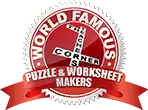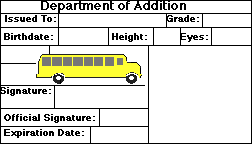 The Teacher's Corner
The Teacher's Corner
Puzzles and Activities
![]()
Addition Subtraction Multiplication Division Miscellaneous
![]() Addition & Subtraction Concentration Grades Early Elementary
Addition & Subtraction Concentration Grades Early Elementary
How about concentration adding and subtraction memory game? Make addition and subtraction cards on file cards. Two or more children play together. Flip all the cards over to the blank side. One card has the number sentence the other card has the answer. Make sure you have a check sheet in the middle so the kids can check the answer. I also play where one child gets to be the checker and 2 play. They rotate so everyone gets to play. Who ever gets the most pairs of cards wins.
Submitted by: Patty in Centerport, NY.
![]() Addition License Grades K-2
Addition License Grades K-2

This idea can be adapted to use for any math function (subtraction, multiplication, etc.)
Submitted by: APool37253@email-removed
What is the Most Expensive Name? Grades Various
A reproducible worksheet that uses an alphabet code to reinforce addition skills.
Goldmine Grades Primary
A game to practice adding and subtracting 9, 10 and 11 to numbers.
I Can Lick 30 Tigers Today! Grades 1
A lesson plan that uses a Dr. Seuss story to teach subtraction.
![]() Memorizing Multiplication Facts
Memorizing Multiplication Facts
Summary: Here is a helpful way for students to get those facts memorized.
"I write out the multiplication facts (0x0 to 12x12) on the chalkboards; that's 169 problems in all! Then I tell my students to copy them all down and that for homework they'll be tested on those facts shortly. You can imagine the complaints! I remind them that math is filled with patterns and ask them if they can discover any patterns in the multiplication problems. Pretty quickly, someone spots that any number times zero equals zero. I erase 25 problems from the board and we're off and running! They quickly teach themselves the rules for multiplying by ones, twos, fives, tens, and most of the elevens. Someone notices that 3x4 is the same as 4x3 and that there are others like that, so the remaining duplicates are eliminated. What we have left are a paltry 29 multiplication problems that they have to write down and learn (far less than the 169 we started with). We practice a few each week, knowing that distributed practice is how students learn their facts, and within a couple of months, all of the second graders know their multiplication facts through the twelves!"
Submitted by: Jay Edwards [email protected], a resource specialist at Hemet Elementary School in Hemet, California.This tip was published in the NEA's Weekly "Works4Me" Email list.
![]() Bunches and Bunches of Bunnies Grades 3-5
Bunches and Bunches of Bunnies Grades 3-5

Use this fun book to integrate literature into your multiplication lesson.
by Louise Mathews, Jeni Bassett (Illustrator)
Multiplication Bingo Grades 3-5
A simple classroom game to reinforce learning of multiplication facts.
Picture Multiplication Grades 1-2
A lesson plan that describes a multiplication activity. Students cut pictures out of magazines to make multiplication sets.
Side-by-Side Division Algorithms Grade 3-6
Students use "short division" prior to being introduced to the long division form.
![]() Increasing Math Skills Grades 3-5
Increasing Math Skills Grades 3-5
Summary: Use the current holiday to spruce up your school days counting.
"At the beginning of each month I cut out shapes according to the season or the holiday. Everyday we write a number on a shape and place it on the wall around the perimeter of the room to count each day of school. We also do some quick calculating using the numbers to increase math skills. For example, 'How many days has it been since day 100?' 'How many days until the end of school?' 'How many months in 180 days?' 'What is the average number of days in a month?' 'How many weekend and vacation days in a school year?' In some instances, the level of multiplication or division we use has not been taught, but I put the problem on the board and we work it through. Now, having reached long division, several students know it already just by doing our daily math."
Submitted by: Clare Delano cdteach98@email-removed, a fourth grade teacher. This tip was published in the NEA's Weekly "Works4Me" Email list.
![]() It Can Be Grades 2-6
It Can Be Grades 2-6
Summary: A quick and easy way to review basic facts.
"When I have some time at the end of the day, I play IT CAN BE with my class. A child holds up an addition sum and the class has to give the problem. For example, if the card says 17, someone called on might say 9 + 8. If the flashcard says 8 + 9, the child holding the card would say, IT COULD BE BUT IT'S NOT. If the child says 9 + 8, the child holding the card would say, IT COULD BE AND IT IS. The children have to give the problem exactly as it's written on the card. If a child gives a completely incorrect answer such as 9 + 6, the response is, IT COULDN'T BE. The child that answers correctly gets to be the next one to hold up the flashcard. This game is a great activity for enhancing math thinking skills."
Submitted by: Beverly Whitson mb_bbwhit@email-removed, a third grade teacher at Lindley Park School in Asheboro, North Carolina. This tip was published in the NEA's Weekly "Works4Me" Email list.
![]() Math Worksheets
Math Worksheets
Use our Math Worksheet Generators to whip out some printable math worksheets in a snap!
![]() Self-Check Math Fact Cards Grades K-2
Self-Check Math Fact Cards Grades K-2
This is a fun and easy project for younger students.
![]() Teaching Thinking Skills Grades 6+
Teaching Thinking Skills Grades 6+
Summary: Use puzzles and stories to help your students develop skills in solving multi-step problems.
"I gather puzzlers and problems from the Internet, math magazines, old textbooks and other publications. Each day, I put a challenging problem on the overhead and give my students time to work on it. When I call 'time,' I place a square of tag board on the desks of those who got the correct answer. The students write their names on the squares and place them in a can. I draw one name. That student has to explain the method he or she used to get the answer. The student receives a prize for a good explanation. Then, I ask for other students to share explanations. Students benefit from having to explain their thinking and from seeing multiple methods of solving problems. I am amazed at the variety of methods they use to solve problems."
Submitted by: From Susan Reid Susabella4@email-removed, a seventh and eighth grade Algebra teacher at Olive Branch Middle School in Olive Branch, Mississippi. This tip was published in the NEA's Weekly "Works4Me" Email list.
![]() Triangle Flash Cards Grades K-2
Triangle Flash Cards Grades K-2
This is a great math center for younger students. Triangle Flash Cards: On each corner of a triangle, you have a number in a certain fact family. So on one card, you may have 2,3, or 5 written in the corner (one number in each corner). The child is to say the fact family number sentences that go with those numbers. So they will say 2+3=5, 3+2=5, 5-3=2, 5-2=3. These reinforce fact families and help them see the relationships between addition and subtraction problems. I make mine on poster boards cut into triangles with rounded corners about the size of my hand.
Submitted by: Txtchr@email-removed
Who has More or Less?: An Addition and Subtraction Game Grades 2-4
Students will practice adding and subtracting mentally as well as attach the words "more" and "less" to adding and subtracting. This is a fun alternative to traditional math drills
![]() EMAIL us your favorite operation resource.
EMAIL us your favorite operation resource.